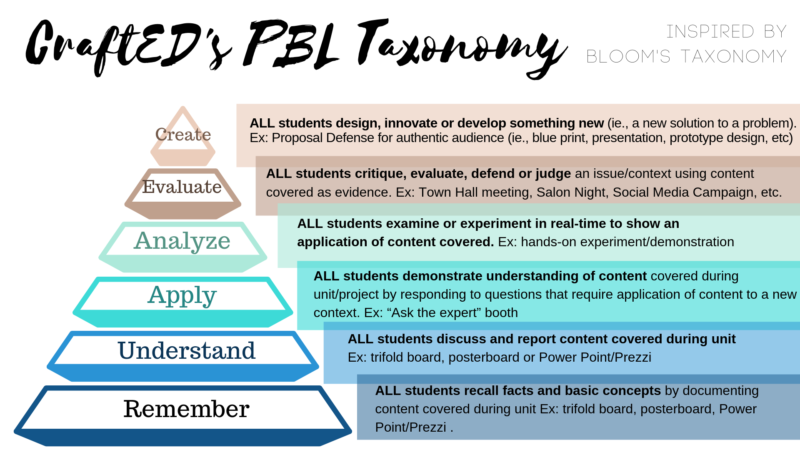Problems With Project-Based Learning: What PBL Isn’t
By Dr. Jenny Pieratt
When we think of school projects, we may fondly remember the Christmas sock we decorated in elementary school or the presentation we gave on anemia in eighth-grade. Learning through projects isn’t new. In fact, projects have formed an important part of education for almost 100 years. However, unlike traditional projects which are assigned as end-of-term assessments, project-based learning (PBL) is student-led and forms the core of the curriculum. In short, PBL is the vehicle through which crucial skills and content are learned, not an assemblage of PowerPoint presentations, homework, and end-of-term assessments. As Jeff Robin reminds us, “Do not discount real-world work for test grades.”
Project-Based Learning is not a PowerPoint Presentation
Project-Based Learning is not a PowerPoint Presentation, nor is it a brochure, a poster, or a sculpture. It’s easy to believe that fun, short project assignments allow students to process the content they’ve just learnt, but this does not truly constitute the development that occurs during project-based learning. In such cases, the teacher “covers the main course of study in the usual way, and then a short “project” is served up for dessert”, to quote John Larmer of PBL Works. We all know that listening to 35 presentations on the same topic is painful for both the teacher and the students. That is just one of many problems with project-based learning that results in a dessert rather than main course. To do this, special emphasis should be put on the role of the audience, though public exhibitions which encourages spectators to participate, give feedback, or become changemakers themselves. CraftED offers several PBL resources which can transform public exhibitions into interactive and symbiotic experiences where everybody learns. For example, one class at Lake Elementary School, in California, asked each participant in their exhibition about water to make a pledge tied to their call to action. And if students choose to represent their work through a PowerPoint presentation, it should be the final touch to a culminating experience which allows students to deeply reflect on their work and development.
Project-Based Learning is not Homework
Teachers often wonder whether or not project-based learning should be done at home, but the truth is that PBL should be kept in the classroom as much as possible. Why is that? Firstly, not all students have the same access to resources at home, whether it be materials, time, or parent involvement to support their work. As a result, one of the worst problems with project-based learning as assigned homework is that it sets inequitable conditions for student learning. A second reason why it’s best to facilitate project-based learning at school is that the chances for dessert projects increase when they’re assigned as homework. Fluffy assignments that showcase well in the classroom should be avoided as they don’t tend to serve PBL. However, assigning some homework is perfectly appropriate, such as preemptive brainstorming, additional research with provided resources and/or correspondence with experts. Students can even revise project drafts after receiving peer feedback at school, update their digital portfolio, or work on skill development at home. Challenge option work, as explained in CraftEd’s new e-course, is also a great homework idea. Nonetheless, teachers should still pay special attention to equalizing opportunity for access, resources and support even when using these assignment ideas.
Project-Based Learning is not an End of Term Assessment
To uphold the best assessment practices, teachers need to frequently evaluate student development and content understanding throughout project work. Continuous assessment allows educators to have open and honest dialogue with students about the skills they could improve, so that each student has the opportunity to correct their weaknesses throughout the project and earn growth points. Project-based learning should lead both teachers and students to view assessment as a journey, not a destination. In the best examples, PBL is done at school and all grading is done before the final presentation. For instance, oral communication, speaking and listening skills, and “production and distribution of writing” skills can be assessed at the culminating event, but also during rehearsal. And if you really want to grade content and skills at the final event, you can do so through hands-on experiments during which students explain what they are doing or “Ask the Expert” booths with scaffolded efforts to engage the audience. In short, while making frequent assessment a reality can seem daunting, it doesn’t need to be one of your problems with project-based learning, especially if you have the right resources.
What Project-Based Learning Truly is
If you avoid the three pitfalls discussed above, project-based learning becomes an engaging standards based assessment applied to the real world. After all, “if we wish to prepare a generation of students who can solve real-world problems, we must give them real-world problems to solve”, to use John Larmer and John R. Mergendoller’s words. In the City Arts and Technology High School, for example, math students, using algebra, discover the “most cost-effective land allocation” for vacant spaces in San Francisco and send recommendations to their mayor. Ultimately, if your resolve the problems with project-based learning, you find yourself with a long-term initiative which teaches significant content and 21st-century skills, makes room for student autonomy, and includes in-depth and often public reflection processes.


